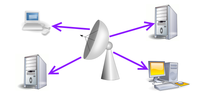Distributed computing projects
From Just Solve the File Format Problem
(Difference between revisions)
Dan Tobias (Talk | contribs) |
(Category:Websites and online services) |
||
| (3 intermediate revisions by one user not shown) | |||
| Line 2: | Line 2: | ||
|formattype=electronic | |formattype=electronic | ||
|thiscat=Distributed computing projects | |thiscat=Distributed computing projects | ||
| + | |image=Distributed-seti.png | ||
}} | }} | ||
| Line 9: | Line 10: | ||
* [[BOINC]] (Berkeley Open Infrastructure for Network Computing) | * [[BOINC]] (Berkeley Open Infrastructure for Network Computing) | ||
* [[SETI@Home (classic)]] (original SETI@Home system from before they switched to BOINC) | * [[SETI@Home (classic)]] (original SETI@Home system from before they switched to BOINC) | ||
| + | |||
| + | == Links == | ||
| + | * [http://www.wired.com/wiredenterprise/2013/06/43651/?cid=co8510144 Web-based distributed computing project using JavaScript to solve chess problem] | ||
| + | |||
| + | [[Category:Websites and online services]] | ||
Latest revision as of 19:23, 7 June 2017
Distributed computing projects (or volunteer or grid computing) are projects that make use of the spare computing cycles of many volunteers' computers in order to do large-scale projects which would otherwise require expensive supercomputers. Various protocols and file formats are used to store and transfer the raw projects and their finished results.
- ArchiveTeam Warrior
- BOINC (Berkeley Open Infrastructure for Network Computing)
- SETI@Home (classic) (original SETI@Home system from before they switched to BOINC)
